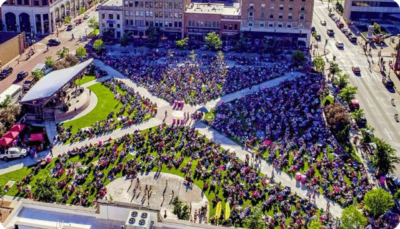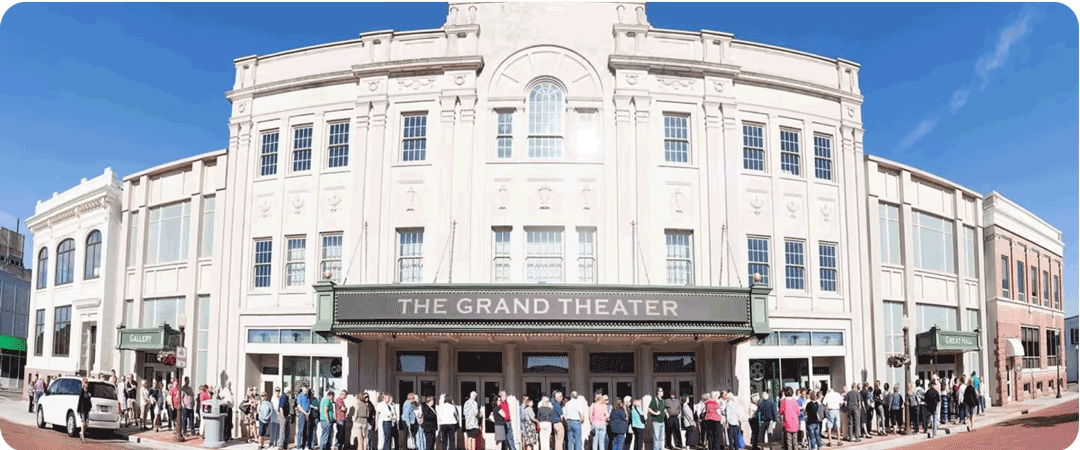Wausau’s downtown adapts to changing times
The River District bustles with activity, growth
As the 21st century got underway, downtown Wausau faced many challenges and was in decline. The combination of deferred maintenance, competition from outlying big-box stores, and the departure of businesses to suburbs robbed the central business district of its vibrancy. Wausau’s downtown mall, like many around the nation, struggled to meet the needs of modern consumers.
But in the early 2000s, the community came together to identify revitalization approaches and joined the Wisconsin Main Street Program, which provides intensive technical assistance in downtown design from WEDC’s development staff and consultants.
New development between 2002 and 2017 was fueled by $26 million in private investment and $93 million in public assistance. Façade improvements were made, commercial vacancies dropped—and that was just the start.
Turning the corner

Liz Wendt
“Revitalizing the central business district takes patience,” says Liz Wendt (formerly Brodek), the City of Wausau’s previous development director. “You have to always be looking to the next thing, understanding when you see an opportunity, weighing the cost-benefit analysis and what you’re going to get out of an opportunity.”
Over the years, Wausau has taken advantage of services available through the Wisconsin Main Street Program to develop a downtown brand, measure the economic impact of the district and its revitalization efforts, quantify downtown residential demand, and identify nighttime streetscape improvements to create a more inviting district. Wisconsin Main Street also funded a study to help the community plan for the future transition of the mall property. Businesses in the district have enthusiastically participated in training on retail and storefront merchandising, restaurant management, and succession planning. A total of 45 renderings have been completed for properties in the district, helping owners and businesses carry out effective and impactful renovations.
Wausau’s River District, which encompasses most of the downtown area, evolved as an arts, entertainment, and social area. The historic Grand Theater was restored and expanded, the former Wausau Club was repurposed as the Wausau Museum of Contemporary Art, and the art-deco Federal Building underwent a $5 million renovation for residential housing. The community implemented placemaking strategies, providing public art and creating the 400 Block, an outdoor performance venue and community gathering spot—thus giving people more attractive reasons to visit the downtown. An internationally known kayaking course also draws people to the area.
 Local specialty shops, restaurants, and bars opened their doors, and the River District’s sidewalk traffic picked up. Events like Concerts on the Square at the 400 Block, Downtown Wausau Dining Week, and the First Thursdays music and retail event thrived.
Local specialty shops, restaurants, and bars opened their doors, and the River District’s sidewalk traffic picked up. Events like Concerts on the Square at the 400 Block, Downtown Wausau Dining Week, and the First Thursdays music and retail event thrived.
The Main Street America organization recognized the River District’s revival in 2019 as one of three national winners of the Great American Main Street Award.
“Wausau River District has set an example for communities across the country that are looking to cultivate sustainable, long-term revitalizations in their downtowns,” Patrice Frey, National Main Street Center president and CEO, said in making the award.
Building on downtown success
Since winning the prestigious award, the River District has not stood still and is adapting to post-COVID realities. Wendt, who in July 2024 became WEDC’s director of business and community operations, said WEDC’s Main Street Bounceback Grants, which provided small businesses with $10,000 grants to help them move or expand into vacant commercial spaces during the pandemic, helped sustain downtown success. And Community Development Investment Grants through WEDC helped bring a bakery and the Children’s Imaginarium to life. The children’s museum, which was in the city’s comprehensive plan since the 1990s, opened in December 2023.
“It’s STEM-focused and heavily based in Marathon County. They talk about how things like locally produced ginseng grow and have displays on wind and water power,” Wendt says of the facility, which drew 12,000 visitors from 52 ZIP codes in its first four months.
 The museum is located in a section of the downtown mall that wasn’t demolished. Most of the mall was razed to make way for other projects on the 10-acre parcel, notably the Foundry on Third, a mixed-use development that will provide 154 housing units downtown. That project broke ground in May 2024.
The museum is located in a section of the downtown mall that wasn’t demolished. Most of the mall was razed to make way for other projects on the 10-acre parcel, notably the Foundry on Third, a mixed-use development that will provide 154 housing units downtown. That project broke ground in May 2024.
Also in 2024, the Wausau River District achieved Gold Tier Main Street status based on the organization’s strong leadership, effective organization, and community engagement.
Now, the city is also grappling with post-pandemic office building vacancies as workers increasingly work from home. For example, a developer has recently purchased a completely vacant building on Scott Street with plans to do an office-to-residential conversion with a coworking space and a restaurant. More bars and restaurants are opening after the pandemic, Wendt says, including an alcohol-free establishment called Forward Beverage. River District events have also expanded to encompass diversity, including examples built around cultural heritage and Pride month, she adds.
“Wausau has been strategic. We’ve been persistent, and we’re always on the alert for changes that can bring opportunity,” says Wendt.


